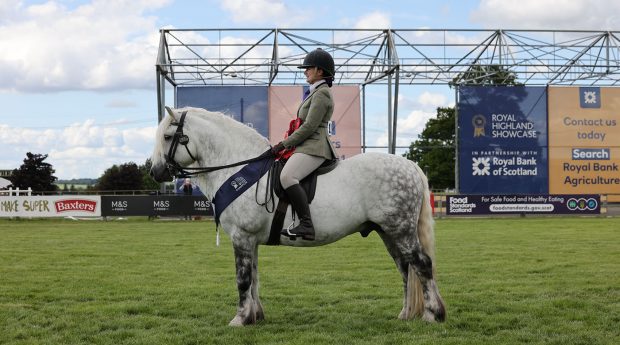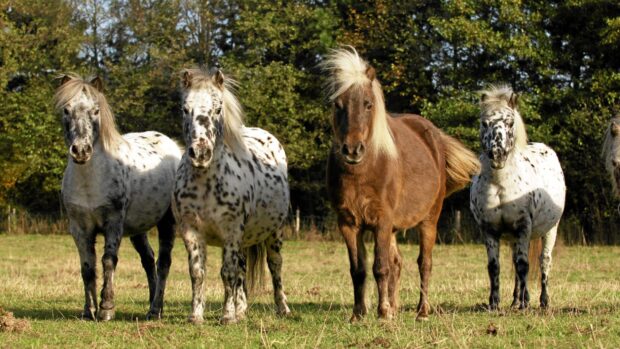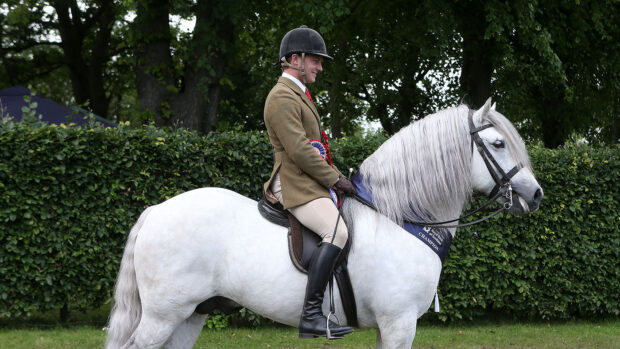The Highland pony was originally bred in parts of Scotland and on the Western Isles but there are now studs located throughout Scotland, England, Wales, Europe and across the rest of the word.
The Highland Pony is one of the two native breeds of the Scottish Highlands and Islands (as well as the Shetland). Over many centuries, the breed has become adaptable to the severe conditions and climates experienced in the areas. The Rare Breeds Survival Trust (RBST) recognises the breed as in a vulnerable state at present.
The Highland should not exceed 14.2hh and is ideally no smaller than 13hh.
The Highland Pony Society (HPS) provides the following breed description:
The Highland Pony is a strong, well-balanced, compact pony with all its features being in proportion to its height. It is one of the largest of the British native breeds and should show substance and strength.
Head: Well carried and alert with kindly eye. Broad muzzled with a deep jowl.
Neck and shoulders: Reasonable length of neck from wither with a good sloping shoulder and well placed forearm.
Body: Well balanced and compact with plenty of room for heart and lungs. Ribs well sprung.
Quarters and hindlegs: Powerful quarters with well developed thigh, strong second thigh and clean flat hocks.
Legs: Flat hard bone, broad knees, short cannon bones, oblique pasterns and well shaped broad dark hoofs. Feather soft and silky.
Mane and tail: Hair should be natural, flowing and untrimmed with a full tail.
Colours: A range of duns, mouse, yellow, grey, cream. Also grey, brown, black, bay and occasionally liver chestnut with silver mane and tail. Many ponies have a dorsal stripe and some show zebra markings on legs and shoulder. Foal coat colour often changes and many ponies change colour gradually as they grow older, especially those with grey hairs interspersed with the original colour. Others show a slight seasonal change in colour between winter and summer coats. Broken colours are not allowed. A small star is acceptable but other white markings are discouraged.
Stallions with white markings other than a small star are not eligible for licensing.
The Highland is to move with a straight action which is free moving without undue knee action.
In an article, breeder Gillian McMurray states that:
“There should not be high knee action, neither should the pony ‘daisy cut’. The pony is expected to move at a workmanlike pace and cover the ground at walk with the hind hoof at least tracking up with the front one.”
The breed is known for being a ride, drive and pack animal which can carry weight (in accordance to suitable limits) and adapt to many equestrian disciplines.
According to the International Museum of the Horse, few relevant early records exist for the Highlands of Scotland: “It is not certain if wild horses spread into Scotland after the retreat of the last glaciers around 10,000 years ago, or if the first ones were brought with prehistoric settlers. In any case, horses were present in Scotland by at least the 8th century BC. The horses/ponies used in Pictish times (about 550-800AD) in East and Northern Scotland, and shown on their carved stones, presumably passed on genetic input to today’s Highland pony.
“We find Highland ponies described in the first travel accounts and agricultural surveys in the 18th century. The ponies then were smaller due to the harsh conditions under which they lived. Most present-day Highland pony bloodlines are traceable back to the 1830s.”
“For the last 170 years Highland ponies have been the main means of transporting deer and other game off the hill, using special pack saddles, as well as many other jobs on the Scottish sporting estates.”
Today, the Highland is still used for its traditional job but is an equally popular family pony for riding and driving. Many are capable jumpers and can also perform well during long distance rides.
In the show ring, Highland ponies are increasingly popular and hold their own in mixed competition. In 2018, the stallion Melanie Stanford’s Benbreac Of Crolia became the first ever native pony to land the supreme accolade at the Royal International Horse Show.
Highland ponies have their own breed final at the Horse of the Year Show. In 2012, the dun stallion Stirlingdene and Frazer Atherden won the supreme pony of the year title and Highlands have also won the Olympia Mountain and Moorland ridden final on numerous occasions.

Benbreac Of Crolia was the 2018 RIHS supreme pony, becoming the first native to land the title
Her Majesty The Queen is known for her love of the breed. Her Majesty is a patron of the society and has a large working stud of Highland ponies, breeding under the Balmoral prefix.
The HPS states that: “During the season, sixteen ponies work over the various beats carrying stags and hinds and panniers for the grouse days. Working Highland ponies also take visitors to enjoy trekking on the estate. The Balmoral Stud goes from strength to strength and has recently been using Ulleam of Croila with their broad-based line of mares.”
The strength and sound temperament of Highland ponies make them good work horses and they are still used in areas inaccessible to machines, such as in logging or to extract deer carcases from the hill.

Balmoral Ulleam tacked up with a deer saddle.
The Highland Pony Enthusiasts Club says that the fact that Highlands perform well in comparatively slow work such as trekking, forestry and deer-carrying suggests that they have a calm, steady temperament: “This makes them outstandingly suitable for the nervous or elderly, and they have also been used successfully as mounts for disabled riders, all of whom appreciate their confidence-giving attributes. However, it must not be thought that, because they are kind and reliable, they are also dull. For many a Highland has shown itself to be a keen, active ride in the hunting field and, correctly schooled, to be able to compete with great success in Pony Club and Riding Club activities — making up by sure-footedness and handiness what it may lack in outright speed. With the present revival in harness work both for showing and for pleasure, the ponies are once more proving their worth in this field also. Safe, reliable, friendly, a good, comfortable ride, constitutionally strong and hardy, attractive to look at, and with considerably more versatility than is generally appreciated, the Highland pony has so much to offer.”




